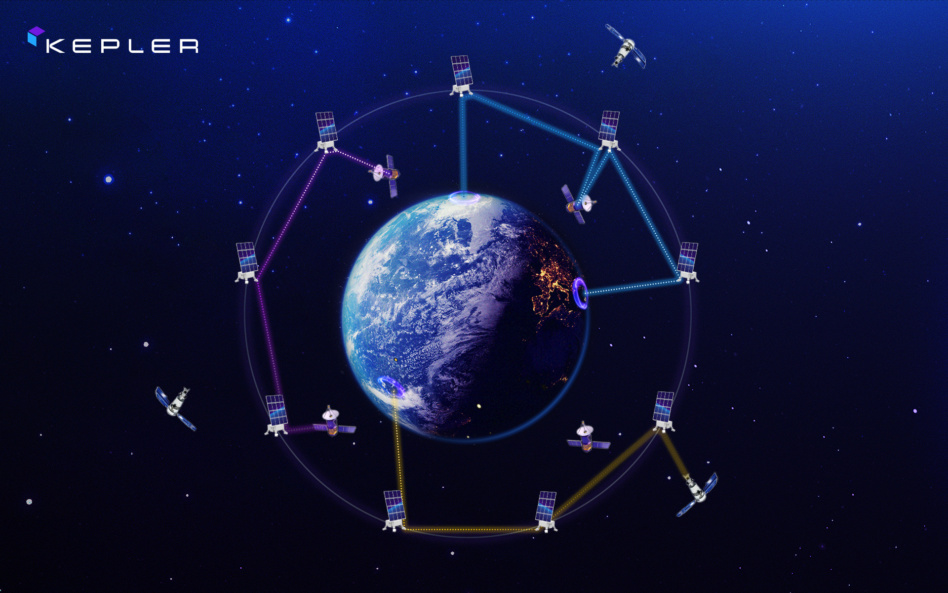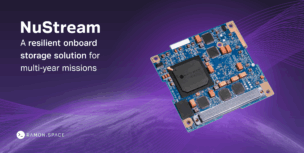Just as fiber optic technology transformed internet communications across the Earth, optical inter-satellite link (OISL) technology enables high-speed comms in space.
Kepler Communications is building the critical infrastructure to solve compounding data needs in space with The Kepler Network, an optical data relay constellation designed to be the transport layer for space comms.
An overdue overhaul
“Since the early days of the space age, the communication conops for most sensing satellites hasn’t changed much,” said Kepler’s Technical Director, James Spicer.
A satellite orbits around the Earth, and when it has line-of-sight visibility to a ground station, it broadcasts a radio signal. The amount of time satellite operators can access their satellite and its data is fundamentally limited by the ground segment. “It’s like having a cellphone but you can only use it for a couple of hours each day,” said Spicer.
Often, there is a lag time of several hours between satellite data collection, downlink to the ground, data processing, and then delivery to the end customer. “If you can shorten that time from hours down to minutes, or even seconds, which Kepler is doing, the value of the satellite’s data increases 10x, 100x, or more,” said Spicer.
Replacing NASA’s TDRSS
In the 1980s, NASA launched the Tracking and Data Relay Satellite System (TDRSS) to provide near-constant communications for critical space missions. As that constellation reaches the end of its life, NASA has turned to the commercial sector to provide the next-generation satellite relay system.
“Kepler is launching a commercial version of TDRSS,” said Spicer. “But we’re using a different orbital geometry and state-of-the-art technologies.” By switching from radio to optical frequencies, OISLs enable low latency, high throughput, and enhanced security. “It’s the equivalent of switching from copper and dial-up to broadband, fiber-optic internet.”
An optical transmission is like a laser pointer. “Operators can transmit hundreds of beams without them ever interfering because they are so narrow, a fraction of the beamwidth of radio transmissions,” said Spicer. Narrower beams enable many operators to use the same frequency bands simultaneously, and they are also more secure as beams are virtually impossible to intercept.
Over the next few years, Kepler will deploy a couple dozen relay birds that satellite operators can tap into for space-to-space and space-to-Earth relay comms. Its first two optical-equipped pathfinder satellites were launched to LEO in November of 2023.
Crucially, Kepler Network’s real-time connectivity will help relieve comms congestion for customers:
- The radio frequency (RF) transmitters in use by today’s satellites often have wide beams. If every satellite is using the same frequencies and broadcasting in the same ground station region, those signals start to interfere.
- “It’s as if a crowd was gathered in one space, all yelling at the same time, making it difficult to identify each person’s voice from the others,” said Spicer.
Regulators are cracking down on the congestion issue, making it more difficult to get frequency allocations. This can be a real barrier for new companies entering the industry, as it may take many years to get a spectrum license.
Onboard processing power
In addition to light-speed data transfer and simultaneous user access, The Kepler Network of satellites also features powerful onboard processing capabilities to expedite tasking, cueing, and decision-making.
Today, many satellite sensors collect raw data, which is then downlinked in its entirety and processed on the ground. What if that data could instead be processed in space? By increasing the speed of space-to-space communication, customers can utilize Kepler’s satellites’ onboard processors to do just that, saving costs on data backhaul and deriving actionable intelligence far more quickly, more securely, and without the need for a human in the loop.
Consider a wildfire monitoring scenario where a wide-view satellite passes over a region and identifies areas of concern:
- In a process taking just a few seconds, the satellite beams its data over to a Kepler satellite, which processes the data and determines any hotspot locations.
- The hotspot coordinates are then sent over the Kepler Network to task a following higher-resolution satellite passing over the region to measure the fires’ size and direction of movement.
Compare that scenario with having to wait for a ground station pass to downlink gigabytes of data, chug through all the processing, find the coordinates, and then wait for the next ground station pass to uplink tasking to the second satellite. By that time, it could be hours later, and the fires have already moved on and grown. Data processing in space and using one satellite’s insights to task the next satellite can happen very quickly and without humans in the loop.
“Kepler will be the first company to launch a satellite constellation specifically dedicated to real-time space data relay,” said Spicer.
Timeline to transformation
In June 2024, Kepler successfully established optical inter-satellite links between two Pathfinder satellites equipped with Space Development Agency (SDA)-compatible TESAT SCOT80 optical terminals.
Kepler also demonstrated Internet Protocol (IP) mesh networking on orbit by communicating with multiple satellites in real time over a single ground link using standard protocols including Secure Shell (SSH), Transmission Control Protocol (TCP), and User Datagram Protocol (UDP).
Kepler’s first tranche of operational optical satellites is scheduled to launch in October 2025, with initial optical services available in early 2026 once each satellite is maneuvered into position. The hybrid optical data relay network builds on flight heritage from Kepler’s previous constellation of 21 RF satellites.




